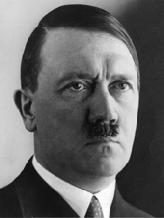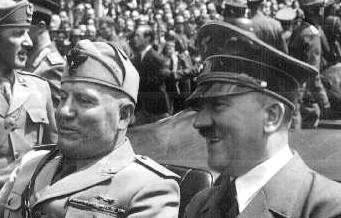Family Background
Hitler was born in Austria just
across from German Bavaria, son of a customs officer originally named Alois
Schicklgruber (surname of Alois' mother; the identity of Alois' father
was unknown – which later became the subject of much speculation!).
It was decided to change the family name to that of an uncle – Hiedler,
except that when it was officially recorded the spelling came out Hitler.
After several failed marriages Alois married Klara P÷lzl, a relative
of his, whose first three children then died young. Adolf was thus
carefully protected by his mother. Other children came along – plus
the family had children from Alois' previous marriages. Alois was
a also very short-tempered. And he tended to move the family around
a lot. It all made for a chaotic childhood.
Early Years
Hitler went to Catholic school
and for a while even considered becoming a monk. His interests then
transfered to German nationalism – which ran strong among many Austrian
Germans who wanted to be linked to Germany rather than Austria-Hungary.
His grades, which were never
too good, only began to worsen when his father died when Adolf was 13 – and
was left with the responsiblity of heading up the family (his older half-brother
had run away). At age 16 Adolf dropped out of school altogether.
In the meantime Hitler was
developing an interest in art. At age 18 he applied for entrance
into the Vienna Academy. But he was subsequently rejected for
lack of apparent talent. Trying to continue his career as artist
anyway, he kept himself barely alive in Vienna for the next six years on
the basis of a variety of menial jobs.
In 1913, greatly discouraged
by his failed Vienna efforts, he moved to Munich and found work as a draftsman.
When World War One broke out he entered a Bavarian regiment, advanced to
corporal, and was wounded and decorated toward the end of the War.
Early Political Activities
After the War he became actively
involved in a small radical German political group which in 1920 took the
name National Socialist German Workers' Party (NSDAP) – or "Nazi" for short.
In 1923, during the period of continuing post-war disruption, Hitler and
his Nazis joined with other dissident political factions in an attempt
to overthrow the Bavarian government. The plot failed and he was
forced to serve a 9-month sentence at the Landsberg jail. Here he
dictated to his friend Rudolf Hess his political manifesto:
Mein Kampf
(My Struggle). After his release he had this work published (1925).
Hitler was an active organizer
and was able to expand greatly the Nazi membership under his growing leadership.
 German
Chancellor German
Chancellor
In 1932 he was so bold as to
submit his name for the German presidential elections of 1932. Hindenburg
was elected instead.
But a year later, with German
politics immobilized by in-fighting among the traditional German parties,
Hindenburg turned to Hitler and his Nazi Party to form a German coalition
government. Hindenburg thought Hitler was a fool whose political
following could be manipulated to advance his own political agenda.
But Hitler proved to be surprisingly impossible to control. Indeed,
as German Chancellor, Hitler was so bold as to suspend the German constitution
of Weimar (not well supported in economically depressed, post-War Germany
anyway). When the German parliamentary building, the Reichstag, was
mysteriously burned, Hitler used this as an occasion to hunt out the "enemies"
of Germany (meaning, his own personal enemies.) Then in 1934 Hitler,
through his personal bodyguard, the SS, undertook a murderous purging of
his own political ranks to further strengthen his complete hold over the
Nazi Party. Slowly Hitler was bringing all of Germany under Nazi
power, and Nazi power under his own personal authority.
 Directing
German Expansion Directing
German Expansion
He played boldly to German nationalist
feelings, gathering popular support as he went. In 1935 he rearmed
the German army, in direct violation of the Versailled Treaty of 1919.
The next year, 1936, he signed a military pact with Italian dictator, Benito
Mussolini. He then began to look East to acquire Lebensraum
or new territories for German expansion. He began with the forced
incorporation of Austria into his growing German Third Reich or
Empire in 1938. He then pressured Czechoslovakia to give up lands
along the German border (which contained Czechoslovakia's major defenses
against an expansionistic Germany) – which the international community,
under representation by English Prime Minister Chamberlain, agreed to,
in order to save the world from war. Instead, it fired up Hitler's
ambitions all the more.
Steps Leading to World War Two
Even though England and France
had extended their protection to Poland in the form of a military treaty,
Hitler was convinced that the French and English had no heart for war – after
the disaster of World War One. He assumed that Poland would be an
easy pick. But Russia was a threat and he knew he had to neutralize
Russia in order to invade Poland. So he made a secret deal with Russian
dictator Stalin to divide Poland between them. On September 3, 1939
Hitler invaded Poland from the West. Soon thereafter Russia invaded
from the East, pretending at first that it was entering Polish territory
as a protector. The Poles were helpless.
Sitzkrieg
Hitler proved to be somewhat
right in his assessment of the French and English. He was wrong in
that they declared war on Germany. Hitler was shocked. But
quickly Hitler came to realize that this was a mere formality. Neither
England nor France showed any real interest in engaging Germany in battle.
Thus Europe entered the phase of the Sitzkrieg, or "Sitting War."
 Attack
on the West Attack
on the West
In the late spring of 1940 Hitler
would wait longer on the English and French to take action, and instead
took action himself by suddenly invading to the West and North of Germany.
He struck against the British and French by invading neutral Belgium, by-passing
French defenses, catching the British expeditionary army in Europe by surprise
(it barely escaped from the beaches of Dunkirk) and struck south toward
Paris, capturing it in a matter of weeks. He also invaded Denmark
and Norway to the North – though he continued to respect Swedish neutrality.
He then turned his thoughts to an invasion of England – beginning with a
summer-time bombardment of English cities and towns (the Battle of Britain).
Opening a Second Front
These easy victories began to
affect Hitler's logic, drawing him into the belief that he alone understood
proper military strategy. This piece of vanity was to draw Hitler
deeper into military commitments that exceeded the abilities of even the
very capable German military and national populace. When the Battle
of Britain failed to produce English surrender (Churchill had by this time
taken over as English Prime Minister and was stiffening English moral resistance
to the Germans) Hitler began to look around for new victories for his Reich.
He looked Eastward to Russia and began the plans to invade there.
Into Russia
Facing numerous delays, the
invasion of Russia did not get going until June of 1941. Though the
invasion proceeded rapidly, Russia was a vast land to conquer. Hitler
was hoping for anti-communist sentiments to aid him in his invasion into
the Soviet Union. In part he was correct – except that his strongly
racist vanity would not allow him to cooperate with the Slavs who might
have made common anti-commuist cause with him. As the Germans slaughtered
the Russians and Ukrainians, they stiffened the anti-German resistence
of their enemies. Things bogged down – and when winter came the Germans
were still short of their goal of conquest of the Russian East. The
Russians showed little sign of readiness to surrender.
Now Also the United States
He added to his diplomatic folly
when Japan attacked the United States at Pearl Harbor in December of 1941,
and Japan and America found themselves at war with eachother.
Hitler decided to honor his alliance with Tojo, fellow dictator in Japan,
by declaring war on the United States. Now Hitler was at war in the
East against Russia, in the immediate West against England, and across
the Atlantic against the United States. He had taken on too much.
Domestic Reign of Terror
But his dictatorship required
political hype. As things worsened on the foreign scene, Hitler now
turned up the heat within the lands held by Germany itself. He began
to play to ancient German prejudices by moving to "purify" the Reich of
its internal racial and political enemies, in particular the Jews, Gypsies,
homosexuals and other "undesireables." He also needed to enlist more
labor in his war factories – utilizing forced labor from the occupied lands:
Poland, France, Netherlands, etc. Germany was turning into a nightmare
of oppression.
The Tide Turns against Germany
With the year 1942 military
events began to turn against Hitler's Reich. The Germans fought valiantly.
But they were vastly outgunned. English and American bombers were
now paying daily visits to German cities with their bombers – forcing German
life underground. Industrial productivity amazingly continued to
move forward – but there was little else about life under Hitler except
the brute fact of the war – and the defensive position that the Germans
were now forced to fight from.
The Plot to Assassinate Hitler
As the Russians, English, Americans
and others in 1944 were coming at Germany from all sides, a plot was formed
among old aristocratic Prussian military individuals to assassinate Hitler.
In July Colonel Stauffenberg planted a bomb under the conference table
as Hitler met with his cabinet. Miraculously, Hitler moved from his
usual position just before the explosion – and though he was hurt seriously,
his life was spared. His vengeance was swift and thorough against
the "old guard." But from then on even Hitler could not escape the
sense of vulnerability within his proud Reich.
Collapse and Death
By early 1945 his enemies were
in Germany itself and heading for Berlin, with the Russians from the East
in the lead. In April, with the Russians running through the streets
of Berlin, Hitler, who had been living deep beneath the earth in his military
bunker, took his life inside that bunker. Alongside him died his
mistress Eva Braun and members of the Goebbels family. Hitler's body
was supposedly creamated and secretly buried. But the whereabouts
of that final resting place are to this day still a mystery.
Thus ended a brilliant mind
that step by step had fallen into the service of evil – evil of hitherto
unthinkable proportions.
|

 His
Life and Works
His
Life and Works
 Hitler's Writing and Speeches
Hitler's Writing and Speeches

 Go
to the history section: Hitler's Germany
Go
to the history section: Hitler's Germany

 Miles
H. Hodges
Miles
H. Hodges